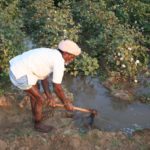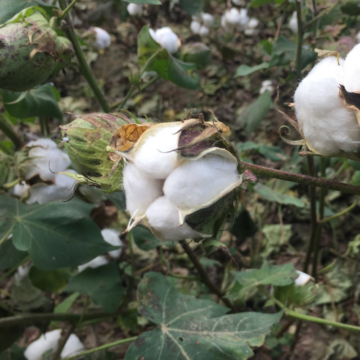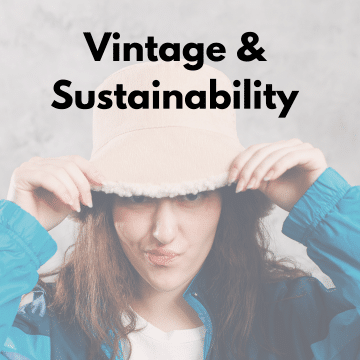I’ve been asked several times how I could work for a company that cares so little for life that we turn a blind eye to the plight of Indian cotton farmers due to Indian suicides. Some people have heard that farmers there are committing suicide because of the biotech seeds we sell. I’ve had long conversations trying to explain the complicated cultural phenomenon that is at fault and illustrate clearly it is not the seeds we sell. I also have personal connections in India who have made it possible for me to see things for myself, to ask people questions. This blog post on Discover Magazine does a clear job of discussing the topic of Indian farmers committing suicide and the reality is complex:
Ironically, the documentary (Bitter Seeds) that perpetuates the GMO/Indian farmer suicide myth also indirectly captures those complex factors. I was actually quite moved by the film, which showed a side of the story that indicts Indian cultural mores and predatory lending practices way more than it indicts Monsanto. This is a side of the story that the Vandana Shiva’s of the world choose to ignore. But don’t take my word for it; watch the movie for yourself.
The truth is that the real causes of farmer suicides in India cannot be pinned on Monsanto, however venal you may regard the company. To discuss those causes you have to wade into a very complex equation that includes institutional, social, and governmental factors in India. Doing this requires a cold objective eye and cultural sensitivity. I’m fairly certain that Vandana Shiva, in her heart, knows well why so many Indian farmers have taken their lives over the last several decades. Just as I’m sure that she knows all about India’s high rate of suicide and the reasons for it. After all, she is a student of inequality and social justice. That Shiva prefers to keep the conversation squarely and inaccurately focused on GMOs and Monsanto reveals to me that she cares more about advancing an ideological agenda than addressing the root causes of suicide in India. That she has succeeded in exploiting real tragedy and distracting conversation away from those true causes is something I find utterly offensive.
Please read the entire article. Reality is the vast majority of Indian farmers have to work their fingers to the bone, they live in tough conditions without nice things like sharp shovels much less tractors. I want to help them improve their lives, make it possible to send daughters to school, have clean water available to them (many carry water for miles to get it to their homes) and to produce enough of a crop that they can sell it fairly.
I was lucky enough to visit India several years ago for work and while there I took some vacation time to visit my friend Geeta’s village and several other places. Seeing what the vast majority of of the Indian public deals with on a daily basis was hard. You see women and children doing heavy labor — picking cotton would be seen as light work compared to the people hauling bricks. You see people using animal dung as a heating source, even for cooking. You see people begging on the streets in ways that make you realize Slumdog Millionaire was probably all too accurate in portraying. Below are some of my trip photos that show you what I mean.
When you live in a world where people complain because the restaurant we are at doesn’t have the exact soda we like, it’s hard to imagine the challenges Indian farmers can face. I have to make myself remember and I have to keep talking to people who can help me see the difficulties in Africa and other world areas. And it’s nearly impossible to understand that a technology that offers a way to limit exposure to insecticides is more than a way to make the job easier, it has the potential for changing your health for the better as you and your kids are no longer breathing in insecticides as you walk the field.
I can see how its easy for people to be vulnerable to stories that sound like an injustice is being done. And injustice should bring outrage. But sometimes what we read on the internet is just a story and the storyteller may have a different agenda than they admit to, like Keith found while at the Botanical Garden.
This brings me to a point I really need to make….
Before you believe the things that are said on the internet, do some research. That can be said of this article as well as the ones that make the other claims. Look at the sources you normally agree with and some of the ones you may not, look for people or groups who may be experts on a topic who aren’t out on book tours, who may just be trying to make a positive difference. There are a lot of people on the internet who use fear as a motivator in others and they manipulate facts. There are also a lot of people who would like to have the truth heard…. they just don’t
I’m okay answering questions about these things as long as people are okay thinking through various information, some of which may not be in line with other things you’ve heard. Use those critical thinking skills we used to cultivate so much as kids and question folks who make big statements about things you are unfamiliar with…. if they really want people to understand what’s happening in the world around them, they will be fine taking time to answer your questions.
Ellen at OneHundredMeals.com also wrote a blog post about an encounter she had with Vandana Shiva. I have never met or heard SHiva speak personally, but have seen video that I felt was incredibly mileading and done so for her own reasons other than honesty.
(Feel like I should remind you about the disclaimer at the bottom of this page. These are my thoughts, not thoughts I am paid to articulate. Now back to work I go.)
- Indian cotton farmer irrigating







I just read the discover article today and found it to be very insightful, thanks for sharing!
You’re welcome. I appreciated the thought-prompter they gave, also was nice to glance back through some photos and remember the true challenges faced in India.
You couldn’t have said a truer word.The farmer suicides are in certain regions regions of the country, and the reasons are not just the quality of seeds but too many complex issues.There has been no rain in the region for many years.Lack of irrigation facilities.No government support to avail of cheaper loans,the subsidy on fuel and fertiliser is slowly being eased out,and if,in spite fending off all these difficulties,you carry some stuff to the market to sell,you realise the traders or middlemen have brought the price of your produce to rock bottom.That is the last straw.The Minister for Agriculture in India was also the head of the Cricket governing body.He had more time for sports than for farmers problems.
Where are you in India? I traveled to Kerala, Andra Pradesh and then the golden triangle with a side trip out to Pushkar.
I live on a farm in Mudhol, which is in north Karnataka,in the southern part of India.I have a riverside farm,so we pump out water from the river to irrigate the crops.But with more demands on the river these days it tends to dry up in the summer months.Welcome to India again,and this time look us up.
.
Just a question as I was frustrated watching that documentary. Regardless of who we want to point fingers at in terms of the cause of suicide, the sales tactics by the seed salesmen are pretty unethical. To give false phone numbers of other farmers is kind of a sham, no? I found those guys to be such a poor representation of any salesman. Pure Cheese.
Also, why would these seeds be sold to farmer who are rain reliant and who operate manually on such small farms? Aren’t the Bt seeds designed for industrial farming and don’t they require more water? Is this something Monsanto looks into or provides insight on to help educate their customers?
Thank you for asking the questions on your mind.
I have to tell you that I have only seen part of the movie and I’m not able to speak to the sales methods of everyone who sells cotton seed. If people are giving fake phone numbers, etc obviously that is unethical. I do know that there are highly ethical sales people in India as well who are part of the communities they sell to and who are looking out for their customer’s long-term interests as well as short-term gains.
Its interesting you would ask about the seeds that are sold to farmers in India because they are different from seeds sold in the US because they are bred for that market. Something which seems to be overlooked fairly often. Years ago I actually had a couple of slides that detailed the differences so I may miss so points but here are a few things to consider. In the US, cotton farmers plant varieties. They want the crop to be consistent over acres so they can manage the field as a whole. In India, we sell cotton hybrids. Hybrids offer higher individual performance but there also tends to be a bit more variability within a field, something that based on the way farmers in India manage small fields and even individual plants is not a problem. So the products we sell in India are created to maximize the way cotton is grown there.
About the water demand, we have a variety of cotton varieties and hybrids, some are able to take better advantage of areas which tend to receive good rainfall or have irrigation readily available — think the Mid-South & Southeastern US and southern/central India versus the more arid/desert-like areas to the west in both countries.
I think what sometimes gets to me is people don’t understand how and why these technologies are so beneficial. I remember meeting a researcher from Rutgers years ago who was studying the use of Bt cotton by small holders in China. What he found was people on these small farms were healthier as they didn’t get exposed to as many pesticides and the training needed for biotech seed was able to be done as seed was purchased and required little protection from exposure. On the other hand insecticides can really provide challenges and many farmers in remote rural areas don’t have access to good safety gear, etc. I found this old slide deck that explains some of that https://www.princeton.edu/morefoodlesscarbon/speakers/carl-pray/Carl_Pray.pdf and small holders have in so many instances changed their situations for the better, being able to send kids to school, being able to purchase a cow, etc. It is truly amazing to see first-hand.
Where there are practices that can help Indian farmers be more productive or efficient with resource use, we have done a variety of training programs. Some of the really neat stuff is done via text message since so many farmers have access to that but may not have computers & email.
Please tell me if this discussion helps any, if you still have questions, etc. I love thinking through these topics and sharing my perspective as well as hearing the concerns of others.
Good writeup Janice. In the US, cotton varieties tend to be somewhat variable (heterogeneous) because of cross-pollination due to the flower type, and it is not considered worth the effort to get them as uniform as wheat or soybeans. F1 hybrids *should* be very uniform (all heterozygous, but very homogeneous). But because F1 seed is so costly to produce, various types of hybrids have been offered to reduce the seed cost, such as F2 hybrids, or double crosses (as in early corn hybrids). Do you know if either F2 hybrids or double cross hybrids are offered in India? I would expect either of them to be a little more variable (or at least as variable) as varieties. One advantage that hybrids have though is usually better stress tolerance, despite what all the anti-technology folks say about them needing more water and fertilizer. They might utilize more if it is available, but they shouldn’t *need* any more than a variety. I know this may be a more technical question than you expected on this blog, but I would be interested to know if you have the answer.
I don’t but will see if I can get a friend to answer.